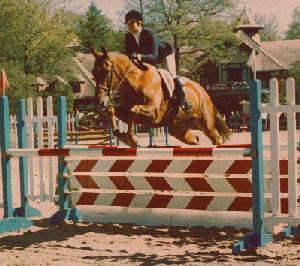In my opinion, a sure way to lose an equitation class is to try so hard to look perfect, that the picture presented is that of a "posed" rider, rather than an effective, natural one. There are no shortcuts to good equitation. If you want to be the best, it's imperative to ride as many mounts as your trainer will place you on, so you can improve your riding skills and effectiveness to the point where you make it look "easy" and the horse you are showing appears to simply acquiesce.

Jill Sternberg Demonstrates A Winning Equitation Position
This rider uses invisible aids. He/she is straight without being stiff. There should be a straight line from the back of your helmet, through the hips and into your heels, which are depressed in a natural way, with body weight being supported by that heel depression.
Often, in an effort to create that secure, tight leg, so illusive to the novice rider, I will observe riders gripping, rather than allowing their weight to depress into the heel. This inexperienced rider will squeeze tightly with the knee in a vain effort towards security. Rather than achieving the tighter leg he or she is striving for, the leg gripping tightly at the knee will create a loose lower leg, with the knee acting like a pivot point and the lower leg swinging from that point, much like a pendelum on a clock. The forced grip squeezes the body upward, having much the same effect a vice like grip would have on a tube of toothpaste, just the opposite of what the rider is hoping to accomplish. The "ideal" equitator will sink deeper into his leg and heel, rather than perching above his base of support.
The upper body is ideally, slightly, almost inperceptibly, in front of the vertical at the walk, sitting trot and the canter and about 20% more forward at the rising trot and hand gallop. At the hand gallop, this rider will elevate his weight out of the saddle into a 2 point position, where contact is made with his/her two legs and no longer in the seat(3 point).
A knowledgable equitation rider establishes a straight line from his/her elbow, through forearms and reins to the horses mouth. When his mount raises his head, the rider will raise his/her hands as well, maintaining that straight line. The same is done when the horse lowers his head, i.e. the rider will lower the hands to keep the same contact and line to the mouth.
A polished equitation rider possesses an independent seat. By that, I mean that his/her position is not dependent on what the horse does, that he/she doesn't need to grab the horses mouth for balance when an awkward situation arises.
I know I'm leaving a great deal out, because describing the "ideal" rider would take much more room than I am permitted on this page. A good book to read to further your education on this subject is "Hunter Seat Equitation" by George H. Morris. I like Anna Jane White Mullin's book on Judging as well.